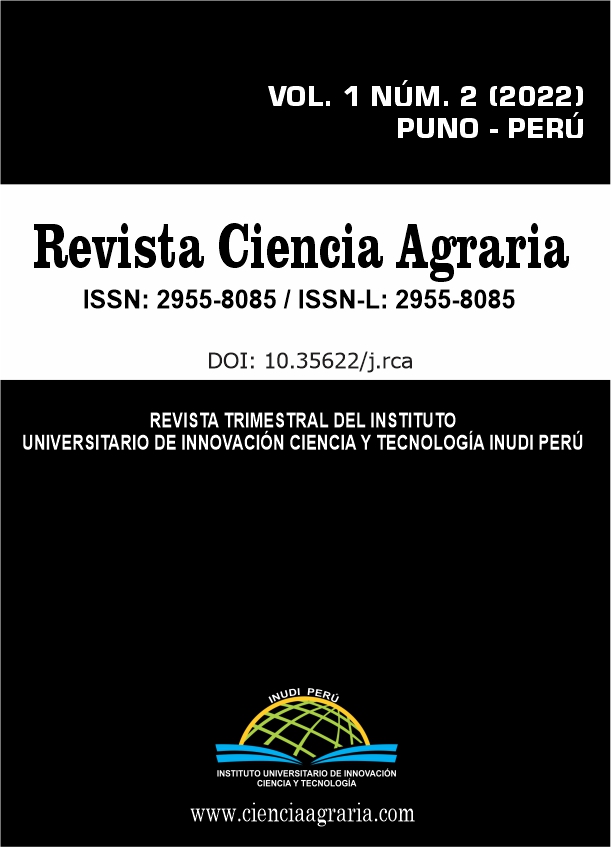Insecticidal effect of eucalyptus and mugwort essential oil against kcona kcona of quinoa cultivation
DOI:
https://doi.org/10.35622/j.rca.2022.02.002Keywords:
insecticidal activity, steam extraction, kcona kcona, pest, toxicAbstract
This research allowed us to evaluate the insecticidal effect of eucalyptus essential oil (Eucalyptus Globulus) and feverfew (Franseria artemisioides) against the kcona kcona (Eurysacca melanocampta) in the cultivation of quinoa (Chenopodium quinoa Willd.). In the development of the process for obtaining oil by steam dragging, the optimal parameters measured were extraction time, temperature and pressure. Characterizing essential oils by gas chromatography coupled to mass spectrometry, where the main components of eucalyptus were Eucalyptol (59.19%), α-Pinene (20.89%) and D-Limonene (6.29%); and mugwort were 5,5-dimethyl-2-ethyl-1,3-Cyclopentadiene (30.65%), β-Himachalene (14.69%) and α-Caryophyllene (10.27%). The physicochemical characterization of density and refractive index of eucalyptus was 0.912 g/mL and 1.4606 respectively, and of mugwort 0.921 g/mL and 1.4857 respectively, performed at 20°C. Regarding the evaluation of the insecticidal activity of the essential oil of eucalyptus and mugwort in the mortality of the Kcona Kcona; the treatments showed effectiveness in controlling the pest. The analysis of variance for the application of eucalyptus essential oil has as optimal values a time of 24 h with a concentration of 1.00%, and mortality of 46.6667%; for the essential oil of mugwort, the optimal values were a time of 24 h with a concentration of 1.00% and mortality of 43.333%.
References
Apaza, M. & Challco P. (2017). “Plantas biocidas para el manejo integrado de plagas y enfermedades de la quinua”. Visión Agraria Revista especializada de la macro región sur. Perú. 40, pp 06 – 09.
Cardenas, M. (1944). Descripción preliminar de las variedades de Chenopodium quinoa de Bolivia. Revista de Agricultura. Universidad Mayor San Simón de Cochabamba (Bol.) Vol. 2, No. 2, pp 13-26.
Catie. (2001). Manejo Integrado de Plagas. Centro Agronómico Tropical de Investigación y Enseñanza. Costa Rica.
Flores, Q., Velasco, A., Hiraola, S. & Giménez, T. (1999). “Aceites Esenciales con actividad citotóxica como indicador de propiedades insecticidas”. Facultad de Ciencias Farmacéuticas y Bioquímicas, Universidad Mayor de San Andrés Instituto de Investigaciones Fármaco Bioquímicas IIFB en el Área temática de Química Farmacéutica – La Paz Bolivia.
Gandarillas, H. (1979). Genética y origen. In: M. Tapia (ed). Quinua y Kañiwa, cultivos andinos. Bogotá, Colombia, CIID, Oficina Regional para América Latina. pp 45-64.
Koul, O., S. Walia, & G.S. Dhaliwal (2008). Essential oils as green pesticides: potential and constraints. Biopes. Int. 4(1):63–84.
Lee, B., Annis, & . Tumaalii, F. (2003). The potential of 1,8-cineole as a fumigant for stored wheat. In E.J. Wright, M.C. Webb and E. Highley (eds.). Proceedings of the Australian postharvest technical conference. June 25–27, 2003. Commonwealth Scientific and Industrial Research Organisation, Stored Grain Research Laboratory, Canberra, Australia.
Loayza N. (1998). “Extracción de aceite esencial de eucalipto con fines farmacéuticos” Tesis de titulación. Universidad Nacional San Antonio de Abad del Cusco. Cusco. Perú.
Madigan, T., Martinko J. M., Parker J., Brook. (1999). Biología de los microorganismos. Octava edición
Mossi A.J., V. Astolfi, G. Kubiak, L. Lerin, C. Zanella, G. Toniazzo, (2011). Insecticidal and repellency activity of essential oil of Eucalyptus sp. against Sitophilus zeamais Motschulsky (Coleoptera, Curculionidae). J. Sci. Food Agric. 91(2):273–277. DOI: https://doi.org/10.1002/jsfa.4181
Murillo-Arango W., Araque P., Henao B. & Peláez, C. (2013). “Actividad Insecticida de una emulsión aceite/agua del aceite esencial de Eucalyptus tereticornis”. Revista Cubana de Plantas Medicinales. Universidad de Tolima. Colombia.
Ochoa, R. y Navia, J. (2013). Morfología y Biología de la Polilla de la Quinua Eurysacca melanocampta Meyrick 2017, (Lepidoptera: Gelechiidae), de Cusco Perú. Centro de Estudios Biológicos Fortunato L. Herrera. Cusco, Perú.
Pant, M., S. Dubey, P.K. Patanjali, S.K. Naik, & S. Sharma. 2014. Insecticidal activity of eucalyptus oil nanoemulsion with karanja and jatropha aqueous filtrates. Int. Biodeterior. Biodegran. 91:119-127. DOI: https://doi.org/10.1016/j.ibiod.2013.11.019
Peruecologico. (2003). http://www.peruecologico.com.pe/libro.htm.
PROINPA. (2013). “Informe Técnico: La quinua, cultivo milenario para contribuir a la seguridad alimentaria mundial. 37ava conferencia de la FAO. Estado Pluricultural de Bolivia.
Quispe, M. (2015). “Evaluación de la Actividad Insecticida de los Aceites Esenciales del Eucalipto (Eucalyptus Globulus) y Romero (Rosmarinus Officinalis), para el Control de Pulgones (Aphis sp.)
Vardar-Unlu, G.; Candan, F.; Sökmen, A.; Daferera, D.; Polissiou, M.; Sökmen, M.; Dönmez, E.; Tepe, B. (2003). Antimicrobial and antioxidant activity of the essential oil and metanol extracts of Thymus pectinatus Fisch. et. DOI: https://doi.org/10.1021/jf025753e
Mey. Var. pectinatus (Lamiaceae). Journal of Agricutural and Food Chemistry 51, 63-67.
Vásquez-Luna A., Pérez-Flores L. y Díaz-Sobac R. (2007). Biomoléculas con actividad insecticida: Una alternativa para mejorar la seguridad alimentaria. Sociedad Mexicana de Nutrición y Tecnología de los Alimentos. México. DOI: https://doi.org/10.1080/11358120709487705
Yáñez, X. & Cuadro, O. (2012). “Composición química y actividad antibacteriana del aceite esencial de las especies Eucalyptus globulus y E. camaldulensis de tres zonas de Pamplona- Colombia” redactado de la Revista de la Facultad de Ciencias Básicas, Universidad de Pamplona, Colombia.
Published
Issue
Section
License
Copyright (c) 2022 Grettel Quispe, Gregorio Palomino

This work is licensed under a Creative Commons Attribution 4.0 International License.











